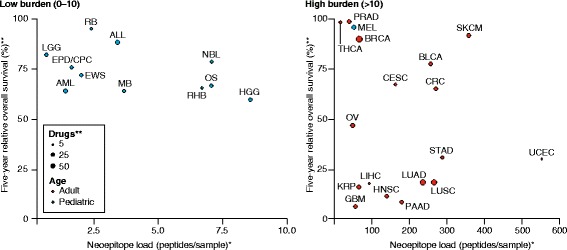Fig. 1.

Five-year relative survival versus neoepitope load in pediatric and adult cancers. Five-year relative survival is plotted against average neoepitope load for 29 cancer subtypes. Dot size represents the number of therapies approved by the US Food and Drug Administration (range 1 to 67) that are indicated for each specific disease. Survival data were obtained from the SEER Cancer Statistics Database (https://seer.cancer.gov), and drug counts for each cancer type were obtained from the A to Z List of Cancer Drugs provided by the National Cancer Institute (https://www.cancer.gov). Neoepitope load numbers are derived from the analyses presented in Chang et al. [7] and Charoentong et al. [8] for children (blue) and adults (red), respectively. *Neoepitope loads represent peptide–HLA binding predictions for missense single-nucleotide variants (SNVs) only. **Drug counts and survival rates for certain displayed subtypes are approximations as the NCI and SEER have grouped cancers differently compared with the sources of neoepitope load data. Abbreviations: ALL acute lymphoblastic leukemia, AML acute myeloid leukemia, BLCA bladder urothelial carcinoma, BRCA breast invasive carcinoma, CESC cervical squamous cell carcinoma and endocervical adenocarcinoma, CRC colon-rectum adenocarcinoma, EPD/CPC ependymomas and choroid plexus tumor, EWS Ewing sarcoma, GBM glioblastoma multiforme, HGG high-grade glioma, HNSC head and neck squamous cell carcinoma, KRP kidney and renal pelvis tumors, LGG low-grade glioma, LIHC liver hepatocellular carcinoma, LUAD lung adenocarcinoma, LUSC lung squamous cell carcinoma, MB medulloblastoma, MEL melanoma, NBL neuroblastoma, OS osteosarcoma, OV ovarian serous cystadenocarcinoma, PAAD pancreatic adenocarcinoma, PRAD prostate adenocarcinoma, RB retinoblastoma, RHB rhabdomyosarcoma, SKCM skin cutaneous melanoma, STAD stomach adenocarcinoma, THCA thyroid carcinoma, UCEC uterine corpus endometrial carcinoma
